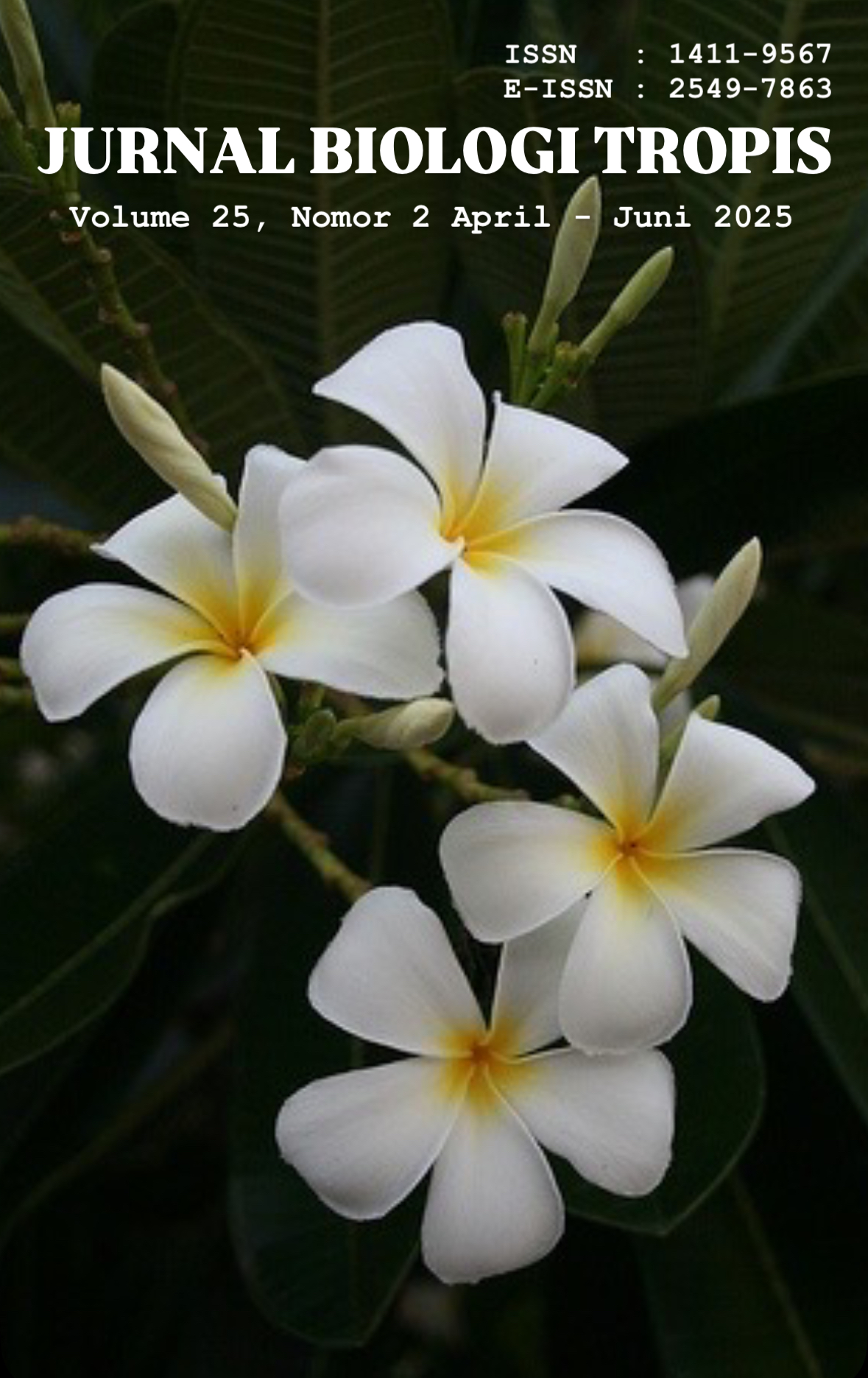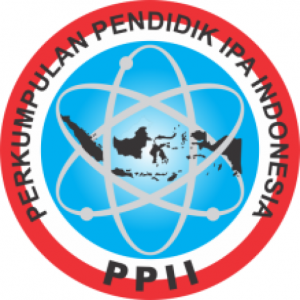Profile of Staphylococcus aureus Originating from Nasal Cavity Swabs of Food Handlers at the University of Mataram Canteen
Authors
Tania Happy Candrawati , Nurmi Hasbi , Rosyunita RosyunitaDOI:
10.29303/jbt.v25i2.8742Published:
2025-04-30Issue:
Vol. 25 No. 2 (2025): April-JuniKeywords:
Food handlers, nasal cavity swab, profile, S. aureus.Articles
Downloads
How to Cite
Downloads
Metrics
Abstract
Staphylococcus aureus is a Gram-positive bacteria that is widespread on human skin and mucosa and can cause a range of ailments, from food poisoning to serious and life-threatening infections. Food handlers are directly linked to food hygiene since they can be a source of infection. The purpose of this study was to detect the presence of S. aureus bacteria in the nasal cavity of canteen handlers in the University of Mataram. This study used a cross-sectional descriptive research design with a population of all food handlers at the University of Mataram canteen. This study was conducted through the stages of isolation, culture, Gram staining, and biochemical detection. The sampling technique used in this study was purposive sampling. This study was conducted on 10 samples of nasal cavity swabs of food handlers in the canteen of the University of Mataram with 5 (50%) positive samples of S. aureus. Meanwhile, the other 5 (50%) samples were indicated to be types of Staphylococcus sp. other species. It can be concluded that the presence of S. aureus was found in food handlers at the University of Mataram Canteen and food handlers are also expected to improve the application of hygiene and sanitation to themselves.
References
Ahmed, Z. A. (2024). Isolation and Diagnosis of Staphylococcus aureus from Wounds and Detection of Some Virulence Factors. European Journal of Medical Genetics and Clinical Biology, 1(5), 198–205. https://doi.org/10.61796/jmgcb.v1i5.511
Alhashimi, H. M. M., Ahmed, M. M., & Mustafa, J. M. (2017). Nasal carriage of enterotoxigenic Staphylococcus aureus among food handlers in Kerbala city. Karbala International Journal of Modern Science, 3(2), 69–74. https://doi.org/10.1016/j.kijoms.2017.02.003
Amin, S. S., Ghozali, T. Z., & Efendi, M. R. S. (2023). Identifikasi Bakteri dari Telapak Tangan dengan Pewarnaan Gram. CHEMVIRO: Jurnal Kimia Dan Ilmu Lingkungan, 1. https://doi.org/10.56071/chemviro.v1i1.563
Amiruddin, R. R., Darniati, & Ismail. (2017). Isolation and Identification of Salmonella sp in Roasted Chicken From Restaurant in Syiah Kuala, Banda Aceh. Jimvet, 01(3), 265–274.
Apriyanthi, D. P. R. V., Laksmita, A. S., & Widayanti, N. P. (2022). Identifikasi Bakteri Kontaminan pada Gelang Tri Datu. Bioma: Jurnal Biologi Makassar, 7(2).
Ariyadi, R., Maulani, P. A., Ruhimat, U., & Hidana, R. (2023). Identification of Staphylococcus aureus Bacteria on the Palms of Visitors to Panumbangan Health Center. Journal of Medical Laboratory Technology, 1(2), 57–64.
BSN. (2015). Cara Uji Mikrobiologi-Bagian 9: Penentuan Staphylococcus aureus pada Produk Perikanan. In Badan Standardisasi Nasional (BSN) (pp. i–19).
Budiyanto, R., Satriawan, N. E., & Suryani, A. (2021). Identifikasi dan Uji Resistensi Staphylococcus aureus terhadap Antibiotik (Chloramphenicol dan Cefotaxime Sodium) dari Pus Infeksi Piogenik di Puskesmas Proppo. Jurnal Kimia Riset, 6(2), 154–162.
Cahyaningtyas, D. E., Gaina, C. D., & Tangkoda, E. (2024). Isolasi dan Identifikasi Bakteri Escherichia coli, Klebsiella, sp., dan Staphylococcus aureus pada Kambing dan Susu Kambing Peranakan Etawa. Jurnal Veteriner Nusantara, VII(04), 1–11.
Ghayyib, A. A., Ahmed, I. A., & Ahmed, H. K. (2022). Isolation, Molecular Identification, and Antimicrobial Susceptibility Testing of Staphylococcus aureus Isolates. HIV Nursing, 22(2), 278–283. https://doi.org/10.31838/hiv22.02.56
Hamtini, & Nuraeni, I. (2018). Isolasi dan Identifikasi Staphylococcus sp. dari Udara di ruangan Ber-AC Gedung Analis Kesehatan. Jurnal Medikes, 5(2), 104–109.
Hasan, R., Acharjee, M., & Noor, R. (2016). Prevalence of Vancomycin Resistant Staphylococcus aureus (VRSA) in Methicillin Resistant S. aureus(MRSA) Strains Isolated from Burn Wound Infections. Tzu Chi Medical Journal, 28(2), 49–53. https://doi.org/10.1016/j.tcmj.2016.03.002
Hasbi, N., Rosyunita, Rahim, A. R., & Ayunda, R. D. (2024). Isolasi Staphylococcus aureus dari Swab Tangan Penjamah Makanan di Kantin Universitas Mataram. Jurnal Kedokteran Universitas Palangka Raya, 12(2), 68–73. https://doi.org/10.37304/jkupr.v12i2.15313
Hayati, L. N., Tyasningsih, W., Praja, R. N., Chusniati, S., Yunita, M. N., & Wibawati, P. A. (2019). Isolasi dan Identifikasi Staphylococcus aureus pada Susu Kambing Peranakan Etawah Penderita Mastitis Subklinis di Kelurahan Kalipuro, Banyuwangi. Jurnal Medik Veteriner, 2(2), 76–82. https://doi.org/10.20473/jmv.vol2.iss2.2019.76-82
Herdianti, Trioktoriana, W., & Noviyanti. (2019). Perilaku dan Karakteristik Penjamah Makanan Terhadap Higiene Sanitasi Makanan Pada Rumah Makan. Kampurui Jurnal Kesehatan Masyarakat, 1(1), 17–25.
Humaryanto, Simanjuntak, C. A., Hanina, & Lipinwati. (2019). Identification of Methicillin Resistant Staphylococcus aureus (MRSA) Using Cefoxitin disc Diffusion Test and Dupleks Polymerase Chain Reaction in Jambi City Hospitals. Journal of Physics: Conference Series, 1246(1), 1–5. https://doi.org/10.1088/1742-6596/1246/1/012016
Imanniarsari, D. E., Miswan, & Nur, A. R. A. C. (2022). Uji Kandungan Bakteri Staphylococcus aureus pada Jajanan Nasi Kuning di SD Kelurahan Lere Kecamatan Palu Barat. Jurnal Kolaboratif Sains, 03(02), 92–97.
Jasim, M. T., Alzubaidi, A. F. A., & Al-Rubaye, S. M. D. (2022). Isolation and Identification of Staphylococcus aureus and Pseudomonas aeruginosa Bacteria from Burns and Wounds Patients in Diyala Governorate. International Journal of Health Sciences, 1(1), 273–282. https://doi.org/10.53730/ijhs.v6ns9.12222
Jawetz, Melnick, & Adelberg. (2008a). Mikrobiologi Kedokteran (R. N. Elferia, D. Ramadhani, S. Karolina, F. Indriyani, & S. S. P. Rianti, Eds.; 23rd ed.). EGC.
Jawetz, Melnick, & Adelberg. (2008b). Mikrobiologi Kedokteran (R. N. Elferia, D. Ramadhani, S. Karolina, F. Indriyani, & S. S. P. Rianti, Eds.; 23rd ed.). EGC.
Karimela, E. J., Ijong, F. G., Palawe, J. F., & Mandeno, J. A. (2018). Isolasi dan Identifikasi Bakteri Staphylococcus epidermidis pada Ikan Asap Pinekuhe. Jurnal Teknologi Perikanan Dan Kelautan, 9(1), 35–42.
Karmakar, A., Dua, P., & Ghosh, C. (2016). Biochemical and Molecular Analysis of Staphylococcus aureus Clinical Isolates from Hospitalized Patients. Canadian Journal of Infectious Diseases and Medical Microbiology, 1(1), 1–7. https://doi.org/10.1155/2016/9041636
Karuppiah, P., Raja, S. S. S., & Poyil, M. M. (2022). Microbiological Profile of Diabetic Foot Infections and The Detection of mecA Gene in Predominant Staphylococcus aureus. Universa Medicina, 41(2), 121–128. https://doi.org/10.18051/univmed.2022.v41.121-128
Kosasi, C., Lolo, W. A., & Sedewi, S. (2019). Isolasi dan Uji Aktivitas Anti Bakteri dari yang Berasosiasi dengan Alga Turbinaria ornata (Turner) J. Agardh serta Identifikasi Secara Biokimia. Pharmacon, 8(2), 351–359.
Kusumo, Y., Atmanto, A. A., Amin Asri, L., Kadir, N. A., Spesialis, D., & Klinik, P. (2022). Media Pertumbuhan Kuman. Jurnal Medika Hutama, 4(1), 3069–3075.
Lasmini, T., Saphira, A., Dos Marliana, L. B., & Sherly Margaretta, T. (2022). Identifikasi Bakteri Staphylococcus aureus pada Swab Rongga Hidung Penjamah Makanan di Jalan Durian Kota Pekanbaru. Prosiding Rapat Kerja Nasional Asosiasi Institusi Perguruan Tinggi Teknologi Laboratorium Medik Indonesia, 1(1), 281–292.
Nuraini, C., Saida, Suryanti, & Nontji, M. (2020). Isolasi dan Identifikasi Bakteri Rhizosfer Tanaman jagung pada Fase Vegetatif dan Generatif. AGrotekMAS, 1, 24–30.
Parija, S. C. (2012). Textbook of Microbiology and Immunology (2nd ed.). Elsevier.
Ramadani, A., Rahayu, Y. P., Nasution, M. P., & Yuniarti, R. (2023). Analisis Cemaran Bakteri Staphylococcus aureus pada Daging Ayam Krispy Pinggir Jalan dan Fast Food di Daerah Teladan kota Medan. Journal of Pharmaceutical and Sciences, 6(3).
Rapi, D. H., Erina, & Darniati. (2017). Isolasi dan Identifikasi Pseudomonas sp. pada Telur Puyuh Burung Puyuh (Coturnix-coturnix japonica) yang Gagal Menetas di Desa Garot Kecamatan Darul Imarah Aceh Besar. Jimvet, 1(1), 19–23.
Rini, C. S., & Rochmah, J. (2020). Buku Ajar Mata Kuliah Bakteriologi Dasar Universitas Muhammadiyah Sidoarjo 2020.
Sakr, A., Brégeon, F., Mège, J. L., Rolain, J. M., & Blin, O. (2018). Staphylococcus aureus Nasal Colonization: An Update on Mechanisms, Epidemiology, Risk Factors, and Subsequent Infectionsii. Frontiers in Microbiology, 9. https://doi.org/10.3389/fmicb.2018.02419
Septiana, Anjarani, A. V. P., & Wahyudi, D. (2024). Identifikasi dan Uji Sensitivitas Staphylococcus Sp. Terhadap Beberapa Antibiotik Pada Ulkus Diabetikum. Media Kesehatan Politeknik Kesehatan Makassar, XIX(1), 91–95. https://doi.org/10.32382/medkes.v19i1
Suryani, D., & Astuti, D. F. (2019). Higiene dan Sanitasi pada Pedagang Angkringan di Kawasan Malioboro Yogyakarta. Jurnal Kedokteran Dan Kesehatan, 15(1), 70–81.
Suryani, Y., & Taupiqurrahman, O. (2021). Mikrobiologi Dasar. LP2M UIN SGD Bandung.
Umarudin, Adnyana, I. G. A., Rohayati, Slamet, N. S., Sembiring, F., Rakanita, Y., Sari, N. K. Y., Sumariangen, A. B., Kurniati, I., Yuliawati, Permatasari, A. A. A. P., Merdekawati, F., & Dermawan, A. (2023). Bakteriologi 2 (H. Akbar, Ed.; Vol. 1). Media Sains Indonesia.
Vinayagamoorthy, G., Mohan, M., & Tamizhmani, M. (2014). Microbiological Analysis and Antibiogram of Different Human Respiratory Infections. International Journal of Advanced Research in Biological Sciences, 1(1), 39–49. www.ijarbs.com
Yanti, N., Yana, D., Dharma, B., & Nugroho, R. A. (2016). Karakterisasi dan Identifikasi Bakteri dari Tamba Daging Babi (Sus sp.) Hasil Fermentasi Spontan. Bioprospek, 11(2), 2016–2053.
License
Copyright (c) 2025 Tania Happy Candrawati, Nurmi Hasbi, Rosyunita Rosyunita

This work is licensed under a Creative Commons Attribution 4.0 International License.

Jurnal Biologi Tropis is licensed under a Creative Commons Attribution 4.0 International License.
The copyright of the received article shall be assigned to the author as the owner of the paper. The intended copyright includes the right to publish the article in various forms (including reprints). The journal maintains the publishing rights to the published articles.
Authors are permitted to disseminate published articles by sharing the link/DOI of the article at the journal. Authors are allowed to use their articles for any legal purposes deemed necessary without written permission from the journal with an acknowledgment of initial publication to this journal.


























